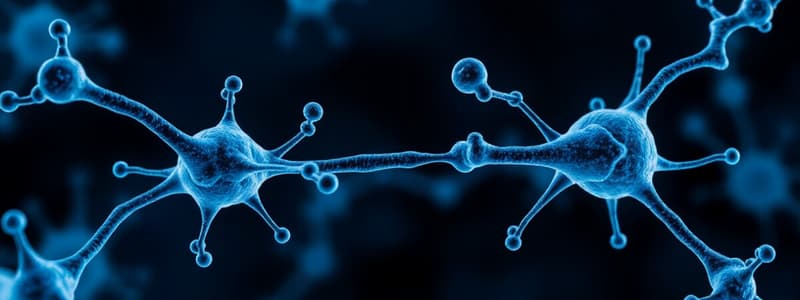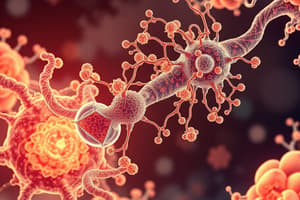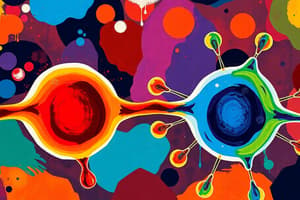Podcast
Questions and Answers
Which type of intermolecular binding interaction is known to be the strongest?
Which type of intermolecular binding interaction is known to be the strongest?
- Dipole-dipole interaction
- Ion-dipole interaction
- Van der Waals interaction
- Ion-ion interaction (correct)
What is the primary purpose of utilizing enzyme inhibitors in medical treatments?
What is the primary purpose of utilizing enzyme inhibitors in medical treatments?
- To prevent diseases caused by specific metabolites (correct)
- To enhance enzyme activity
- To increase drug absorption
- To induce an immune response
Which of the following is classified as an irreversible enzyme inhibitor?
Which of the following is classified as an irreversible enzyme inhibitor?
- Zinc-finger proteins
- Functional antagonists
- Transition state analogs (correct)
- Prodrug activation agents
What type of drug-receptor interaction typically binds more tightly?
What type of drug-receptor interaction typically binds more tightly?
Which enzyme target is a key focus for developing anti-gout agents?
Which enzyme target is a key focus for developing anti-gout agents?
Which characteristic best describes noncovalent interactions in drug-receptor binding?
Which characteristic best describes noncovalent interactions in drug-receptor binding?
Which of the following statements about allosteric inhibitors is true?
Which of the following statements about allosteric inhibitors is true?
Which drug targets are associated with the treatment of male erectile dysfunction?
Which drug targets are associated with the treatment of male erectile dysfunction?
Which type of inhibitor binds to a different site than the active site and can affect the function of the target protein?
Which type of inhibitor binds to a different site than the active site and can affect the function of the target protein?
What characteristic of a drug can significantly affect its solubility and overall bioavailability?
What characteristic of a drug can significantly affect its solubility and overall bioavailability?
The IC50 value is derived from which type of curve related to enzyme inhibition?
The IC50 value is derived from which type of curve related to enzyme inhibition?
In terms of drug-target bonding interactions, covalent bonding is primarily characterized by which feature?
In terms of drug-target bonding interactions, covalent bonding is primarily characterized by which feature?
What approach may be employed in the process of optimizing drug interactions with enzymes and receptors?
What approach may be employed in the process of optimizing drug interactions with enzymes and receptors?
Nanomedicine primarily focuses on which application within drug development?
Nanomedicine primarily focuses on which application within drug development?
What factor significantly influences the choice of receptors targeted by new drug candidates?
What factor significantly influences the choice of receptors targeted by new drug candidates?
Which process utilizes computational methods to predict the behavior and interactions of drug molecules?
Which process utilizes computational methods to predict the behavior and interactions of drug molecules?
What is the relationship between the strength of ionic interactions and the distance between charged groups?
What is the relationship between the strength of ionic interactions and the distance between charged groups?
In which environment do stronger ionic interactions most commonly occur?
In which environment do stronger ionic interactions most commonly occur?
Why are ionic bonds considered important initial interactions for drugs entering a binding site?
Why are ionic bonds considered important initial interactions for drugs entering a binding site?
Which type of interaction is stronger when comparing dipole-dipole and ion-dipole interactions?
Which type of interaction is stronger when comparing dipole-dipole and ion-dipole interactions?
What happens to the electron distribution in C-X bonds due to the electronegativity of X?
What happens to the electron distribution in C-X bonds due to the electronegativity of X?
Which of the following statements best describes ionic interactions?
Which of the following statements best describes ionic interactions?
Which statement accurately compares dipole interactions with ionic interactions?
Which statement accurately compares dipole interactions with ionic interactions?
What type of interaction occurs between a dipole in a drug molecule and an ion in a receptor?
What type of interaction occurs between a dipole in a drug molecule and an ion in a receptor?
What is the mechanism of irreversible enzyme inhibitors?
What is the mechanism of irreversible enzyme inhibitors?
Which of the following statements is true about irreversible inhibitors?
Which of the following statements is true about irreversible inhibitors?
Which of the following is an example of an irreversible enzyme inhibitor?
Which of the following is an example of an irreversible enzyme inhibitor?
What is the primary effect of Orlistat on the digestive process?
What is the primary effect of Orlistat on the digestive process?
What happens to substrate concentration in the presence of irreversible inhibitors?
What happens to substrate concentration in the presence of irreversible inhibitors?
What biological consequence is associated with the use of Orlistat?
What biological consequence is associated with the use of Orlistat?
How does irreversible inhibition affect the enzymatic reaction compared to reversible inhibition?
How does irreversible inhibition affect the enzymatic reaction compared to reversible inhibition?
Which of the following statements accurately describes the binding of irreversible inhibitors?
Which of the following statements accurately describes the binding of irreversible inhibitors?
What is the main function of renin inhibitors?
What is the main function of renin inhibitors?
Which of the following best describes the role of angiotensin II?
Which of the following best describes the role of angiotensin II?
What term describes the intermediate formed during the action of renin?
What term describes the intermediate formed during the action of renin?
Which amino acid residues are primarily involved in the enzyme-catalyzed reaction with renin?
Which amino acid residues are primarily involved in the enzyme-catalyzed reaction with renin?
How do renin inhibitors function as antihypertensives?
How do renin inhibitors function as antihypertensives?
What effect does angiotensin II have on blood vessels?
What effect does angiotensin II have on blood vessels?
What is the primary target of renin inhibitors in the renin-angiotensin system?
What is the primary target of renin inhibitors in the renin-angiotensin system?
What role does the renin-angiotensin system play in cardiovascular health?
What role does the renin-angiotensin system play in cardiovascular health?
How does the strength of ionic interactions change with distance between charged groups?
How does the strength of ionic interactions change with distance between charged groups?
In which type of environment are ionic interactions typically stronger?
In which type of environment are ionic interactions typically stronger?
What kind of interactions occur when dipoles in drug molecules are aligned with oppositely charged ions in receptors?
What kind of interactions occur when dipoles in drug molecules are aligned with oppositely charged ions in receptors?
Which of the following is true about the strength of dipole-dipole interactions compared to ion-dipole interactions?
Which of the following is true about the strength of dipole-dipole interactions compared to ion-dipole interactions?
What is the primary characteristic of electronic dipoles formed in C-X bonds where X is an electronegative atom?
What is the primary characteristic of electronic dipoles formed in C-X bonds where X is an electronegative atom?
What role do ionic interactions play when a drug first enters the binding site of a receptor?
What role do ionic interactions play when a drug first enters the binding site of a receptor?
What is the primary reason that ion-dipole interactions are stronger than dipole-dipole interactions?
What is the primary reason that ion-dipole interactions are stronger than dipole-dipole interactions?
What type of bonding interaction primarily takes place when a drug molecule interacts with its receptor?
What type of bonding interaction primarily takes place when a drug molecule interacts with its receptor?
What is the mechanism by which renin inhibitors affect angiotensin synthesis?
What is the mechanism by which renin inhibitors affect angiotensin synthesis?
Which of the following descriptions best characterizes the role of aspartyl residues in the reaction catalyzed by renin?
Which of the following descriptions best characterizes the role of aspartyl residues in the reaction catalyzed by renin?
What effect does the blockade of angiotensin II synthesis by renin inhibitors have on blood vessels?
What effect does the blockade of angiotensin II synthesis by renin inhibitors have on blood vessels?
Which statement about the tetrahedral intermediate in the renin-catalyzed reaction is accurate?
Which statement about the tetrahedral intermediate in the renin-catalyzed reaction is accurate?
What role do renin inhibitors play in the management of hypertension?
What role do renin inhibitors play in the management of hypertension?
What is the primary benefit of cooperativity in drug-receptor interactions?
What is the primary benefit of cooperativity in drug-receptor interactions?
In the context of binding interactions, which type generally binds most tightly?
In the context of binding interactions, which type generally binds most tightly?
Which type of enzyme inhibitor can result in a permanent loss of enzyme activity?
Which type of enzyme inhibitor can result in a permanent loss of enzyme activity?
Which enzyme target is critical for the treatment of hypertension?
Which enzyme target is critical for the treatment of hypertension?
Which characteristic of noncovalent interactions is crucial for drug efficacy?
Which characteristic of noncovalent interactions is crucial for drug efficacy?
Which type of pharmacological agent primarily targets viral enzymes?
Which type of pharmacological agent primarily targets viral enzymes?
What defines transition state analogs in the context of enzyme inhibition?
What defines transition state analogs in the context of enzyme inhibition?
Which enzyme is a target for antidepressant medications, particularly monoamine oxidase inhibitors?
Which enzyme is a target for antidepressant medications, particularly monoamine oxidase inhibitors?
What characteristic describes reversible enzyme inhibitors?
What characteristic describes reversible enzyme inhibitors?
Why are charged groups preferred in drug design for receptor binding?
Why are charged groups preferred in drug design for receptor binding?
What distinguishes ion-dipole interactions from dipole-dipole interactions?
What distinguishes ion-dipole interactions from dipole-dipole interactions?
Which scenario best describes hydrogen bonding?
Which scenario best describes hydrogen bonding?
How does the interaction strength of ion-dipole interactions change with distance compared to dipole-dipole interactions?
How does the interaction strength of ion-dipole interactions change with distance compared to dipole-dipole interactions?
What is the significance of the ΔGº range of -1 to -7 kcal/mol found in drugs like Zalepan?
What is the significance of the ΔGº range of -1 to -7 kcal/mol found in drugs like Zalepan?
What type of bond does hydrogen bonding represent in the context of molecular interactions?
What type of bond does hydrogen bonding represent in the context of molecular interactions?
In a dipole-dipole interaction, what is primarily responsible for the attraction between two molecules?
In a dipole-dipole interaction, what is primarily responsible for the attraction between two molecules?
What defines the stability of hydrogen bonds compared to other dipole interactions?
What defines the stability of hydrogen bonds compared to other dipole interactions?
Which factor contributes to the strength of ion-dipole interactions over dipole-dipole interactions?
Which factor contributes to the strength of ion-dipole interactions over dipole-dipole interactions?
How does electronegativity influence the formation of dipoles in molecules?
How does electronegativity influence the formation of dipoles in molecules?
What is the primary mechanism through which allosteric inhibitors exercise their effect on enzymes?
What is the primary mechanism through which allosteric inhibitors exercise their effect on enzymes?
How does increasing substrate concentration affect the inhibition caused by an allosteric inhibitor?
How does increasing substrate concentration affect the inhibition caused by an allosteric inhibitor?
What structural characteristic differentiates an allosteric inhibitor from a substrate when binding to an enzyme?
What structural characteristic differentiates an allosteric inhibitor from a substrate when binding to an enzyme?
What is a key characteristic of transition-state inhibitors in drug design?
What is a key characteristic of transition-state inhibitors in drug design?
What is an important challenge in designing drugs that mimic transition states?
What is an important challenge in designing drugs that mimic transition states?
In the context of allosteric inhibitors, which statement is accurate regarding their binding characteristic?
In the context of allosteric inhibitors, which statement is accurate regarding their binding characteristic?
What type of drug design approach may be most effective for targeting transition states?
What type of drug design approach may be most effective for targeting transition states?
What distinguishes allosteric inhibitors from competitive inhibitors?
What distinguishes allosteric inhibitors from competitive inhibitors?
What type of interaction primarily facilitates the binding of allosteric inhibitors to their site?
What type of interaction primarily facilitates the binding of allosteric inhibitors to their site?
Flashcards are hidden until you start studying
Study Notes
Drug-Target Interactions
-
Drug-Target Interactions - Interactions between drugs and their targets are essential for drug action. The interactions can be reversible, irreversible, or transition-state.
-
Forces involved in Drug-Receptor Interactions:
- Major types of bonding:
- Covalent Bonding: Strong, irreversible bond, involves sharing of electrons between atoms.
- Non-Covalent Bonding: Weak, reversible interactions, includes ionic interactions, dipole interactions, hydrophobic interactions, and van der Waals forces.
- Ionic Interaction: Occurs between oppositely charged ions. Strength is inversely proportional to the distance between the charges. Stronger in hydrophobic environments.
- Dipole Interaction: Electrostatic interaction between molecules with permanent dipoles. Weaker than ionic interactions.
- Hydrophobic Interaction: Repulsion of water molecules between non-polar molecules.
- Van der Waals Forces: Weak, short-range interactions between all molecules.
- Major types of bonding:
-
Enzyme Inhibition: Enzyme inhibitors slow down or block enzyme catalysis.
- Reversible Inhibitors: Bind reversibly to the enzyme, allowing the enzyme to regain function after the inhibitor departs.
- Irreversible Inhibitors: Bind irreversibly to the enzyme, permanently inhibiting its activity.
- Allosteric Inhibitors: Bind to a site different from the active site, resulting in conformational changes that alter enzyme activity.
Enzymes
- Why Inhibit Enzymes? Many diseases arise from a deficiency or excess of a specific metabolite in the body. In these cases, inhibiting specific enzymes can normalize the situation.
- Enzyme Targets for Useful Medications:
- Antibacterial agents: Dihydropteroate synthetase, transpeptidase
- Antiviral agents: HIV reverse transcriptase, HIV protease, viral DNA polymerase
- Anti-inflammatory agents: Cyclooxygenase
- Cholesterol lowering agents: HMG-CoA reductase
- Antidepressants: Monoamine oxidase
- Anticancer agents: Tyrosine kinase, dihydrofolate reductase, thymidylate synthase, aromatase
- Antihypertensive agents: Renin, angiotensin converting enzyme
- Treatment of male erectile dysfunction: Phosphodiesterase
- Anti-gout agents: Xanthine oxidase
- Alzheimers disease: Cholinesterases
- Diuretics: Carbonic anhydrase
Enzyme Inhibitors
-
- Reversible Enzyme Inhibitors: Bind reversibly to the active site, allowing the enzyme to regain function after the inhibitor departs.
- Irreversible Inhibitors: Bind irreversibly to the enzyme, permanently inhibiting its activity.
- Allosteric Inhibitors: Bind to a site different from the active site, resulting in conformational changes that alter enzyme activity.
- Transition-state Analogs: Mimic the transition state of the reaction, binding more strongly to the enzyme than the substrate.
Examples of Enzyme Inhibitors
- Nerve Gases: Irreversible inhibitors of acetylcholinesterase, leading to paralysis and death.
- Penicillins: Inhibit bacterial cell wall synthesis by interfering with the transpeptidase enzyme.
- Disulfuram: Inhibits aldehyde dehydrogenase, leading to unpleasant side effects when alcohol is consumed.
- Cephalosporins: Similar mechanism to penicillins, inhibiting bacterial cell wall synthesis.
- Proton Pump Inhibitors: Inhibit the proton pump, a critical enzyme in acid secretion, leading to reduced acid production in the stomach.
- Orlistat: Inhibits pancreatic lipase, reducing the digestion and absorption of fats.
- Renin inhibitors: Block the renin-angiotensin system, reducing blood pressure.
Key Concepts
- Drug-receptor interactions are critical for drug efficacy.
- Cooperativity of multiple weak interactions can lead to strong binding.
- Enzyme inhibition is a powerful therapeutic strategy used to treat a wide range of diseases. Different classes of inhibitors exhibit distinct mechanisms of action.
- Understanding structure-activity relationships (SAR) is essential for drug design and development.
Non-Covalent Bonding
- Non-covalent interactions occur between drugs and receptors
- Weak non-covalent interactions are reversible
- Non-covalent interactions are important for drug binding
Types of non-covalent bonds
- Ionic interactions: The strength of the interaction is inversely proportional to the distance between the charged groups
- Dipole interactions:
- Ion-dipole interaction: The charge on one molecule interacts with the dipole moment of another
- Dipole-dipole interaction: The dipoles in a drug molecule can be attracted by ions or by other dipoles
- Hydrogen bonds: A type of dipole-dipole interaction formed between the proton of a group X-H, where X is an electronegative atom and other electronegative atoms (Y).
Drug bonding Interactions
- Cooperativity contributes to the strength of the interaction
- Charged groups bind more tightly than polar groups, which in turn bind more tightly than nonpolar groups.
Enzymes
- Enzyme inhibition occurs when a compound slows down or blocks enzyme catalysis
- Enzyme inhibition is important for the development of many medications
Enzyme Targets for Useful Medications
- Antibacterial agents: Dihydropteroate Synthetase, Transpeptidase
- Antiviral agents: HIV reverse transcriptase, HIV protease, viral DNA polymerase
- Anti-inflammatory agents: Cyclooxygenase
- Cholesterol lowering agents: HMG-CoA reductase
- Antidepressants: Monoamine oxidase
- Anticancer agents: Tyrosine kinase, dihydrofolate reductase, thymidylate synthase, aromatase, etc.
- Antihypertensive agents: Renin, angiotensin-converting enzyme
- Treatment of male erectile dysfunction: Phosphodiesterase
- Anti-gout agents: Xanthine oxidase
- Alzheimers disease: Cholinesterases
- Diuretics: Carbonic anhydrase
Enzyme Inhibitors (EIs)
- Reversible Enzyme Inhibitors: These inhibitors bind reversibly to the enzyme.
- Irreversible Enzyme Inhibitors: These inhibitors bind irreversibly to the enzyme.
- Allosteric Inhibitors: These inhibitors bind to a site other than the active site, inducing a conformational change in the enzyme that prevents the substrate from binding
- Transition State Analogs: These inhibitors mimic the transition state of an enzyme-catalyzed reaction. These are likely to bind more strongly than drugs mimicking the substrate or product.
Example of Transition State Analogs
- Renin Inhibitors: block the synthesis of angiotensin I and II, acting as antihypertensives.
Studying That Suits You
Use AI to generate personalized quizzes and flashcards to suit your learning preferences.



